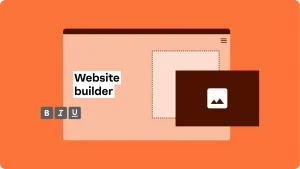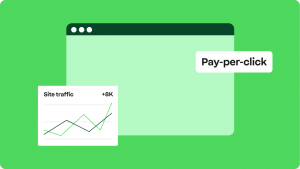Key takeaways:
- You can start affiliate marketing with a social media platform or a blog.
- Helpful content builds more trust than hard selling.
- Using search engine optimization (SEO), email, and social media to grow your audience/leadership helps you earn more over time.
What is affiliate marketing?
Affiliate marketing is a marketing strategy in which a business teams up with individuals or other businesses (called affiliates) to promote its products or services. When a desired action happens—whether it’s a sale, a qualified lead, or a free trial—the affiliate then earns a commission. If the promotion doesn’t convert, the advertiser doesn’t pay the affiliate.
Important terms to remember in this article:
- Affiliate link. A unique link that tracks clicks and conversions.
- Cookie window. How long a link is credited to you (e.g., You earn commission on any purchases completed within 30 days after someone clicks through your affiliate link.)
- Attribution model. Means who gets credit for a sale or lead. It can be based on the last person who encouraged the customer to click (last click). But some programs credit the first person who promoted it (first click) or split the credit between several people (multi-touch).
- Payout model. Either cost per acquisition (CPA), cost per lead (CPL), percent of the sale, or fixed bounty.
How does affiliate marketing work?
The process involves three key parties:
- The Merchant: The company where the product or service is from. This can be a large corporation or an individual entrepreneur.
- The Affiliate: The individual or company that promotes the merchant’s product. This can be a blogger, vlogger, content creator, or website owner.
- The Consumer: The target audience who will see the affiliate’s promotion and will purchase the product.
Let’s go through the steps of how affiliate marketing works, from sign-up to getting your first payment.

- Apply to a program or network.
- Get approved and set up tracking.
- Publish content that features the offer.
- Promote your content.
- User clicks your link and converts.
- You earn commission and get paid.
- Apply to a program or network. You can apply to a program of your chosen brand or sign up with a network like CJ Affiliate, Impact, or Awin. Carefully choose ones aligned with your target audience’s needs, offer fair commissions, reasonable cookie windows, and clear terms, so your efforts will be rewarded.
- Get approved and set up tracking. Once you’re in an affiliate program, you’ll receive unique tracking links for each product or landing page. Set up your payout details, create deep links, and double-check if clicks are showing up in your dashboard.
- Publish content that features the offer. Whether it’s a blog post, review, tutorial, video, email, or social media post, make sure your content naturally includes the product. Match your audience’s intent, include clear calls to action (CTAs), and follow Federal Trade Commission (FTC) disclosure rules.
- Promote your content. Share your content on social media platforms, email newsletters, or paid ads (if allowed and you have the budget). Focus on the platforms your target audience already uses, and always follow the affiliate marketing programs’ rules, especially around ads, email, and trademark usage.
- User clicks your link and converts. When someone clicks your affiliate link, a cookie is set. The sale is tied back to you if they complete a desired action (make a purchase, for example) within the cookie window.
- You earn commission and get paid. After the transaction is reviewed and approved (some programs have a short waiting period), your commission will be added to your account. Your payment will depend on the affiliate program’s schedule, although occasional reversals can happen if a customer requests a refund.
Types of affiliate marketing
There are several ways you can earn a commission, and they’re based on three different types.
1. By commission structure
- Pay-Per-Sale (PPS). The most common model. The merchant pays you a percentage of the sale price when the consumer buys the product after clicking your affiliate link.
- Pay-Per-Lead (PPL). The merchant pays you a fixed commission for each lead generated. This could be signing up for a newsletter, filling out a form, or requesting a quote.
- Pay-Per-Click (PPC). A less common model. You’ll be paid a small amount for every click on your affiliate link, regardless of whether a sale occurs.
2. By affiliate relationship
- Unattached Affiliate Marketing. The affiliate has no personal connection, expertise, or authority in the product’s niche. This affiliate relationship is dependent on PPC advertising and doesn’t involve building a personal brand or audience trust.
- Related Affiliate Marketing. The affiliate has an established online presence, like a blog or social media platform, that’s related to the product niche. They have some authority over their audience but may not have personally used the product.
- Involved Affiliate Marketing. The affiliate has personally used the product and genuinely believes in it by providing personal testimonials and detailed reviews. This method fosters the highest level of trust and authority with its audience, resulting in strong conversions.
3. By marketing channel
Choosing the right channel is one of the most important decisions you’ll make when starting out. This is where you’ll direct your affiliate marketing efforts and create and share your content.
- Social platforms (Instagram, Facebook, TikTok, X, YouTube)
- Blogs and websites
- Email marketing
- Review sites and loyalty/cashback
- Influencer collaborations
- Company partnerships
- YouTube
- PPC ads
Social platforms (Instagram, Facebook, TikTok, X, YouTube)
These platforms are where you can build a personal connection with your audience and create content they can quickly consume. These can be short, engaging demos, mini-reviews, and quick “stories” that point to your link-in-bio or storefront. Use proper disclosures like #ad or #affiliate.
Blogs and websites
These will house your long-form, in-depth content that helps you become a trusted authority in a specific affiliate niche. Here you can write comprehensive guides, detailed comparisons, and “versus” posts that answer your audience’s pressing questions.
Email marketing
This channel is perfect for a welcoming sequence for new subscribers to a weekly digest of your favorite products and exclusive deals.
Review sites and loyalty/cashback
These sites are built to capture people who are already considering buying. When you provide side-by-side rankings and tracking prices, you can help buyers in this stage make the final decision and earn a commission.
Influencer collaborations
This is where you partner with creators who have already built trust from the audience and have a following in your niche. When you collaborate, you can “borrow” their audience and introduce them to your products.
YouTube
You can create detailed reviews, tutorials, and comparisons that build trust. Make sure to include your links in the video description and a pinned comment to make it easy for your viewers to click.
Company partnerships
This is where you cross-promote with complementary brands. For example, if you’re a fitness apparel brand, you could partner with a protein supplement company. This partnership allows you to create bundles, host joint webinars, or feature each other in your newsletters. This will enable you to combine your affiliate marketing efforts with a co-marketing strategy to reach a new audience.
PPC ads
Get traffic to your links quickly by paying for clicks. With PPC ads, you can capture high-intent buyers with search ads or find new audiences. You can set up PPC ads on search engine results pages, social media, or on website pages. Just make sure to follow the specific paid traffic rules of each affiliate program.

How much can I make with affiliate marketing?
Beginners may start at a few hundred dollars per month with the right affiliate marketing strategies, while established affiliates can earn more.
Here’s a simple snapshot:
- Entry‑level (0–1 year): $55,000–$93,000 per year or $4,583–$7,750 per month
- Intermediate (1–3 years): $58,000–$99,000 per year or $4,833–$8,250 per month
- Experienced (4–6 years): $63,000–$111,000 per year or $5,350–$9,250 per month
What affects earnings the most
- Audience size and engagement. A small, dedicated audience that trusts your recommendations will convert more than a huge, passive following. Target high-quality visitors who are actively looking for solutions.
- Niche. Your niche dictates the value of each sale. Software as a Service (SaaS), Finance, and business-to-business (B2B) generally offer higher payouts per conversion compared to mass-market consumer goods.
- Content quality and trust. High-quality and genuinely helpful content, like in-depth reviews and tutorials, can help establish you as a credible source in a particular niche. This authenticity is the biggest factor that convinces visitors to use your affiliate link.
- Promotion strategy and channel mix. A successful affiliate marketer uses a mix of platforms. Combine search-optimized content for organic traffic with email marketing and engaging social content for a diversified, high-yield strategy.
- Geography, company size, and performance pay. Your pay is affected by where your audience lives and the rules of the affiliate program you joined. You generally earn more in regions where there is high purchasing power. Top sellers also get paid more per sale because programs give them higher commission rates when they hit big sales goals.
Note: The figures above are estimates reported by Glassdoor as of April 2025 and may vary depending on demand, industry, location, market conditions, and experience. Always check the latest numbers on the linked page.
Pros and cons of affiliate marketing
Affiliate marketing is a simple way to start an online business since it’s easy to get started. But before you begin, think about its benefits and challenges. Some people make good money, but many don’t succeed because they don’t plan well, pick the right niche, or keep working consistently.
Like any other business model, affiliate marketing has pros and cons. Weigh these factors before you invest and make sure to compare these with your own goals and resources before investing your time and effort.
Pros
- Low startup costs. No need to create your own product or manage inventory. This significantly reduces financial risk and eliminates costly logistical headaches associated with fulfillment. Your time will be spent on content creation and building your audience.
- Flexibility and independence. Work anywhere and set your own hours. You have complete independence to set your own work schedule and choose which products or programs align best with your personal brand.
- Performance-based income. Your earnings are tied to the results of your marketing efforts. This model rewards hard work and effective strategy, making it one of the purest forms of performance-based revenue. You’ll only get paid when a desired action, like a sale or a lead, is completed.
- Scalability. Promote multiple products and expand your content channels as your business grows. You’ll be able to diversify your income streams and test new niches without committing to a single product line.
Cons
- No control over the product. You are at the mercy of the merchant’s product quality, pricing, and business practices. If the merchant changes their commission structure or their product fails, your reputation and income can suffer instantly.
- High competition. Many niches are already crowded with other affiliates. This will require many beginners to put in substantial effort to create truly unique, high-quality content to stand out.
- Payment delays. Commissions are often paid after a validation period to account for possible product returns. This window allows merchants to process returns, cancellations, or fraudulent transactions before releasing your commissions.
- Requires patience. Building an audience and earning significant earnings will take time and consistent effort. As a beginner, you should commit to a long-term strategy because revenue doesn’t immediately materialize in the first few months.
Who should do affiliate marketing?
Affiliate marketing is ideal for people who are passionate about a specific niche and enjoy creating content. This includes:
- Bloggers and writers. These are people who can produce detailed product reviews, how-to guides, and tutorials.
- Social media influencers. These are people who have an engaged following and can create authentic endorsements.
- YouTubers and podcasters. These people can create video or audio content demonstrating the products you sell.
- Website owners. These are people who can build niche sites focused on specific products or services.
Affiliate marketing programs examples
If you’re ready to find a program to join, here are some of the most popular and well-known affiliate marketing programs to consider:
- Amazon Associates. One of the most popular programs, which offers a vast range of products.
- Awin (which acquired ShareASale). A global affiliate network with thousands of merchants across various sectors.
- ClickBank. Known for a wide variety of digital and physical products, including e-books, online courses, health supplements, and other tangible goods.
- Shopify Affiliate Program. For affiliates promoting Shopify’s eCommerce platform.
7 tips for affiliate marketing success
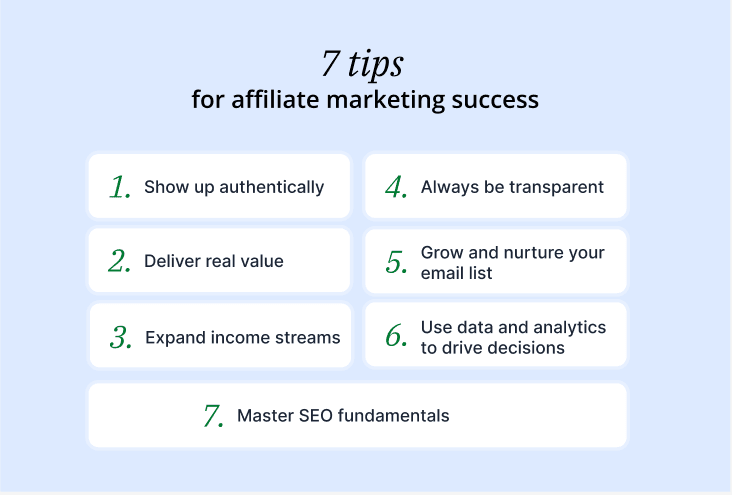
Following these best practices will help you build trust with your audience and increase your chances of success.
- Show up authentically
- Deliver real value
- Expand income streams
- Always be transparent
- Grow and nurture your email list
- Use data and analytics to drive decisions
- Master SEO fundamentals
Show up authentically
Your audience follows you because they relate to you and they trust your judgment. Therefore, you should only promote products you have used personally or genuinely believe in. If you lose your audience’s trust, you’ll lose your audience and affiliate income.
Deliver real value
Create valuable content that helps your audience. Don’t just act like a salesperson. Write in-depth reviews, produce detailed tutorials, or offer creative solutions to their problems. Your goal is to be a resource.
Expand income streams
Don’t put all your eggs in one basket. Relying on a single product or affiliate program is risky. If the program changes its commission structure or the product is discontinued, your potential affiliate sales could disappear overnight. Promote products from different networks and consider multiple monetization strategies like ad revenue or your own digital products.
Always be transparent
Not only is disclosure a legal requirement, but it’s also about trust. Clearly inform your audience that you are an affiliate and may earn a commission from their purchase. A simple statement such as “As an Amazon Associate, I earn from qualifying purchases” or a clear “Disclosure” at the top of your page builds credibility.
Grow and nurture your email list
Your email list will be a direct line of communication with your most dedicated followers. Unlike social media platforms, where algorithms can hide your content, you own your email list. Use it to send exclusive content, special offers, and new product promotions directly to your audience.
Use data and analytics to drive decisions
Don’t just guess what’s working—use data to find out. Pay attention to which links are getting the most clicks, which content is converting best, and where your audience is coming from. Use this information to double down on what’s successful and fine-tune your less effective strategies.
Master SEO fundamentals
SEO is your key to free and long-term traffic. Optimize your content for relevant keywords so that your reviews, guides, and articles appear in search results. This ensures that people who are actively looking for the products you promote can easily find your content.

Affiliate marketing examples
Below are some world examples to help you see how different content creators use affiliate marketing to earn a commission.
Nomadic Matt — nomadicmatt.com (travel)
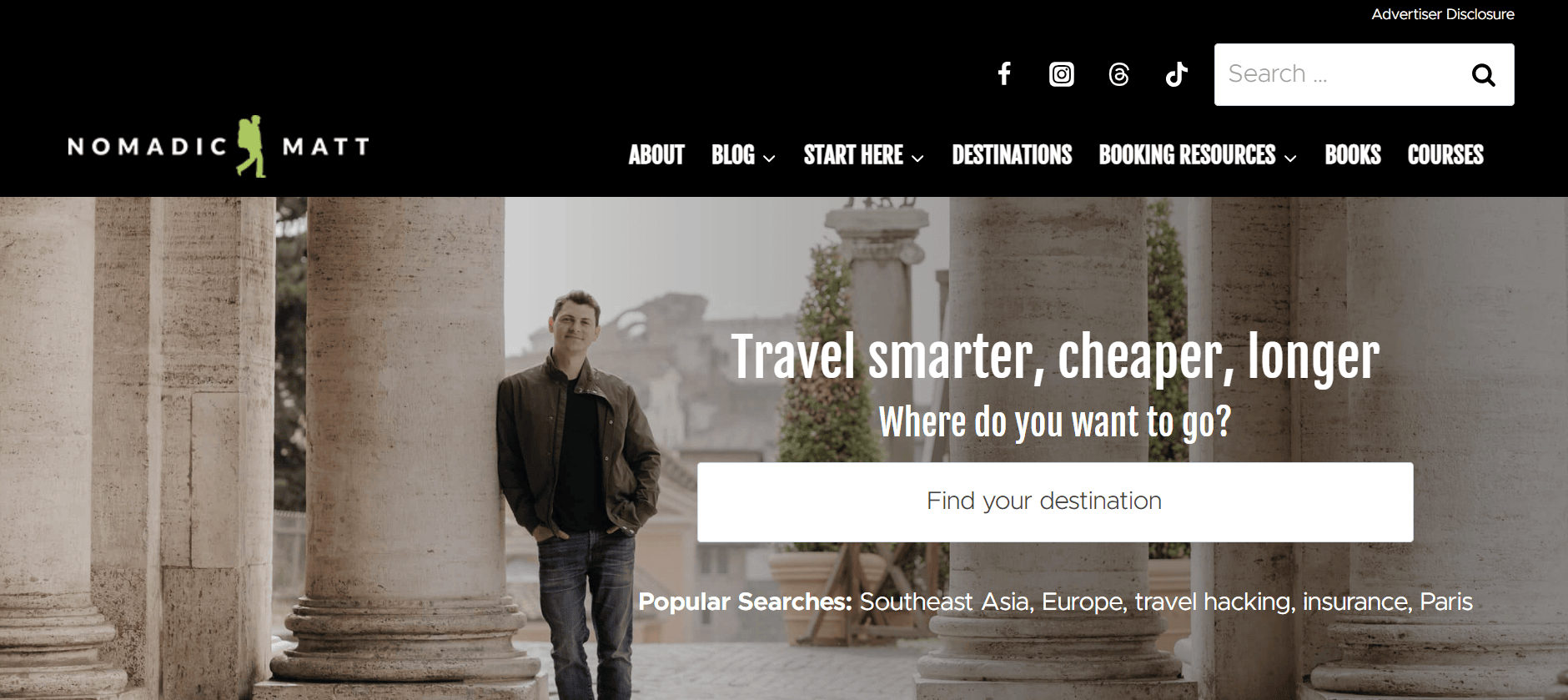
What they do and how links fit: The site offers travel guides and easy-to-follow itineraries with helpful links to flights, accommodations, tours, and travel insurance. Nomadic Matt also uses affiliate links for bookings and resources and maintains a prominent affiliate disclaimer page.
Lindsay Ostrom — Pinch of Yum (food)
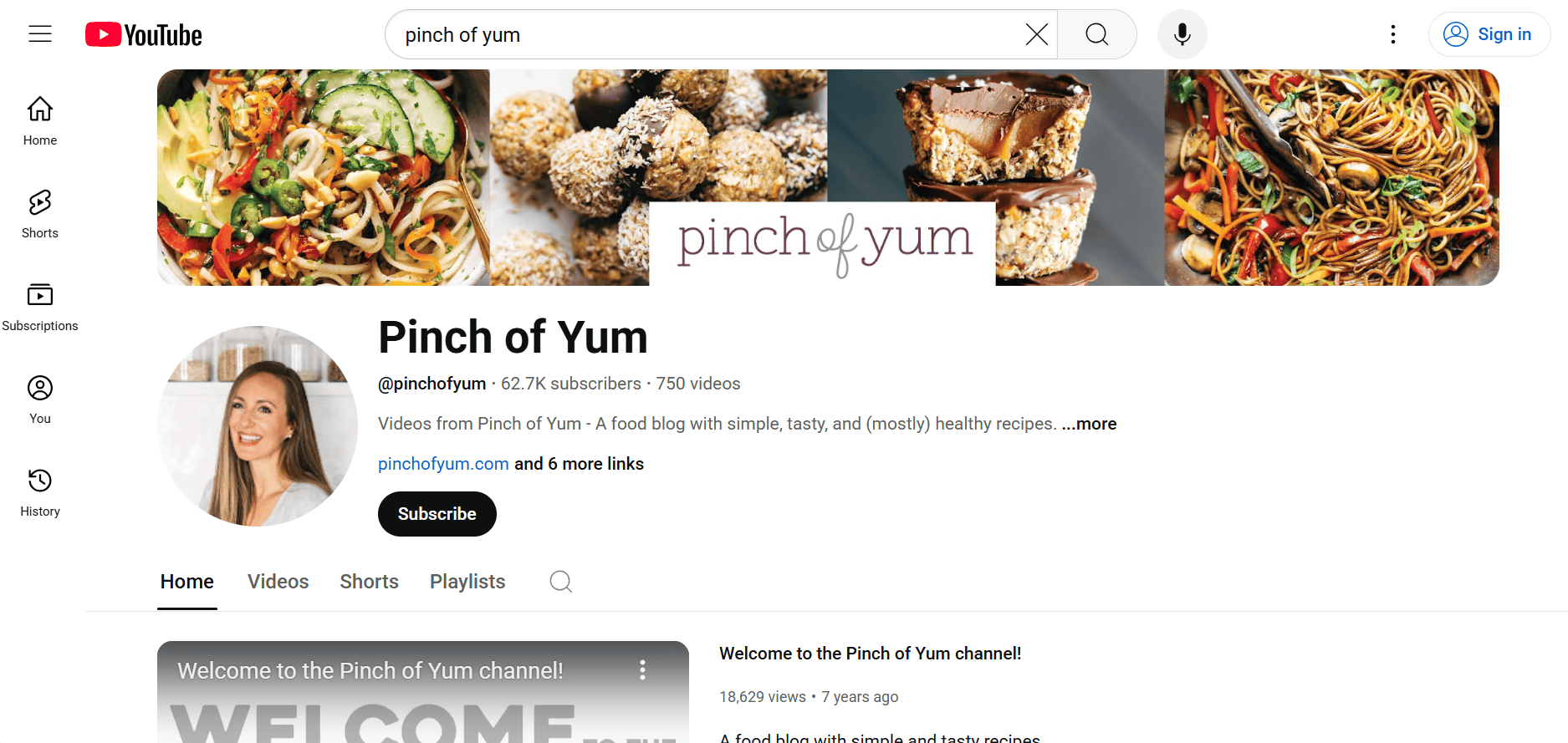
What they do and how links fit: The site shares recipes with beautiful food photography, and mentions cookware, blenders, pantry staples, and even the camera featured in its recipes. Recipe posts and the resources page often include affiliate links to kitchen gear. She also offers her own product affiliate program.
Emily Mariko — @emilymariko (food & lifestyle, TikTok)
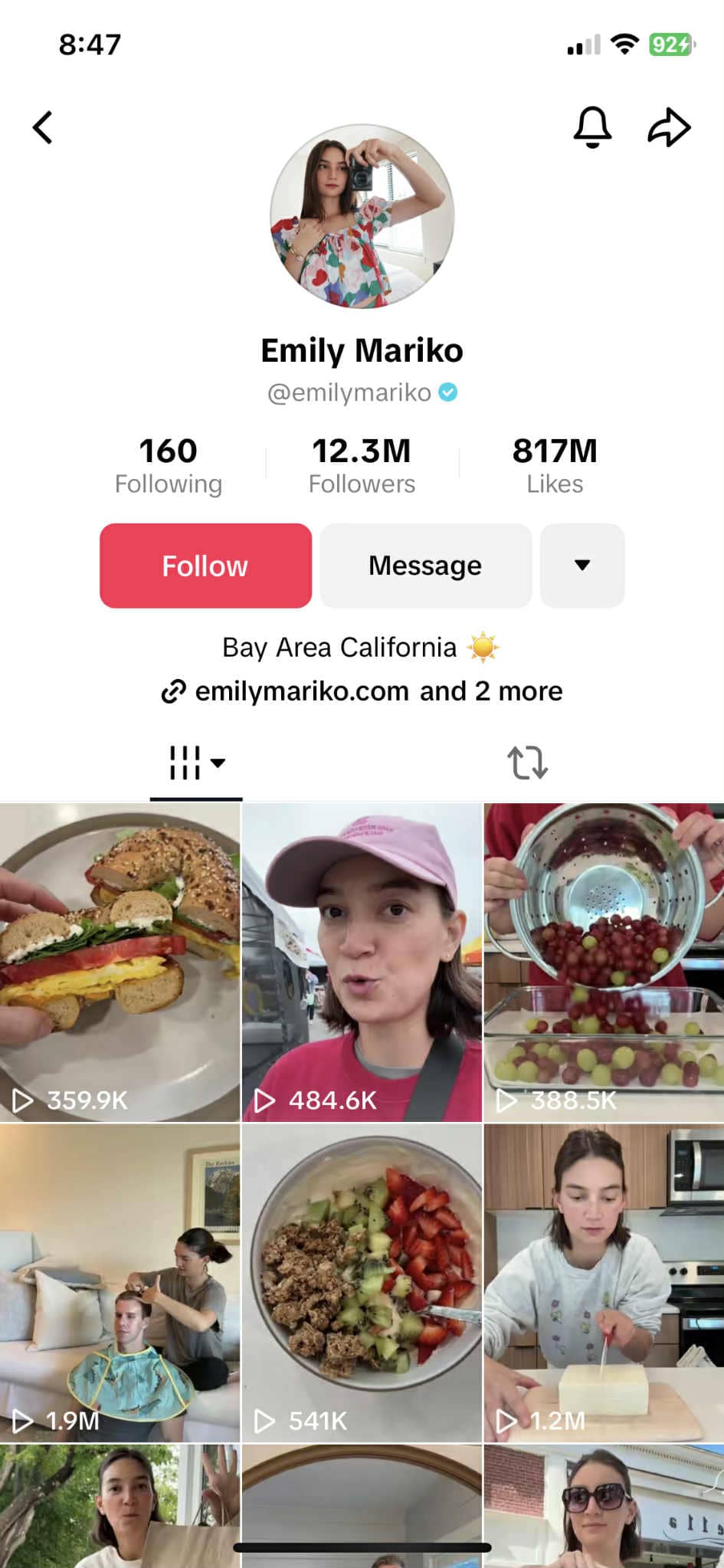
What they do and how links fit: Shares viral recipes and simple kitchen workflows, with affiliate links to appliances, pantry staples, and tools on her Amazon page and link-in-bio so that viewers can purchase the exact items.
Start your affiliate marketing journey today
Affiliate marketing offers a way to earn passive income, but its success doesn’t come overnight. It requires patience, consistency, and a commitment to build trust with your audience by producing authentic content. With the steps outlined in this article, you can create sustainable income streams while being free to grow at your own pace. Whether you’re a blogger, influencer, or business owner, affiliate marketing can be a powerful tool to diversify your revenue and unlock new opportunities online.
Frequently asked questions
Yes, but only after some work at the start. Once your content is live and optimized for SEO, it can become passive income.
Not always. You can use social media or email marketing, though a website helps build authority.
Most beginners earn in 3–6 months with consistent effort, but it varies by niche and strategy.
It depends on your audience. Popular choices include Amazon Associates, Awin, and ClickBank.
High-performing niches include finance, tech/software, health & wellness, and lifestyle products.

